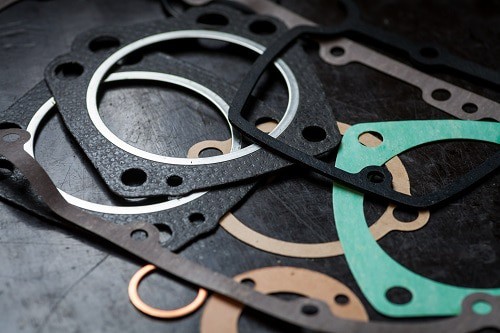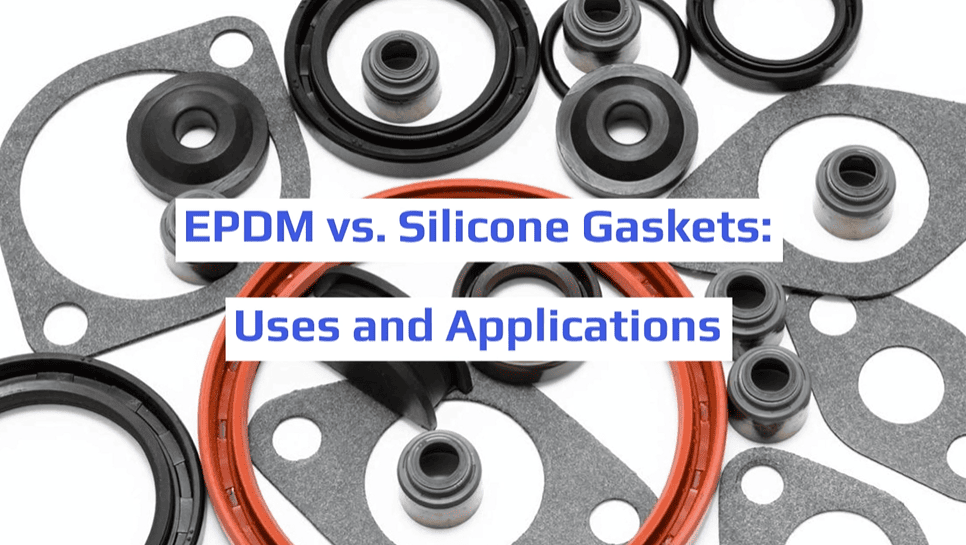Gaskets are crucial sealing and cushioning materials for various residential, commercial, and industrial uses. Selecting the right kind of polymer for the gaskets is key to preventing repair costs, downtime, and other adverse effects should the sealing fail.
Silicone and EPDM (ethylene propylene diene monomer) are popular materials used for gaskets. However, their properties have different pros and cons for certain applications, so the best material choice depends on your industry or application.
Read on to learn more as we discuss the differences between EPDM vs. silicone gaskets, including their respective properties, compositions, benefits, and applications.
What Is EPDM?
 EPDM is a type of synthetic rubber created by mixing various proportions of ethylene, propylene, and diene. The major component is ethylene, which takes up 45% to 75%, while diene monomers give EPDM its cross-linking structure that provides great flexibility, resilience, and durability. EPDM’s molecular mesh structure also gives it superior elasticity and resistance to aging.
EPDM is a type of synthetic rubber created by mixing various proportions of ethylene, propylene, and diene. The major component is ethylene, which takes up 45% to 75%, while diene monomers give EPDM its cross-linking structure that provides great flexibility, resilience, and durability. EPDM’s molecular mesh structure also gives it superior elasticity and resistance to aging.
EPDM rubber is resistant to heat, cold, ozone, steam, electricity, UV rays, abrasion, and water, so it is preferred for various outdoor and harsh environments. Some of its applications include non-slip coatings for decks, cooling system hoses, roofing, HVAC systems, plumbing, and window and door seals in vehicles.
Pros & Cons of EPDM
Here is an overview of the advantages of using EPDM gaskets:
- Lower cost than silicone: EPDM is a great choice if you are looking for a cost-effective option with excellent performance in harsh outdoor conditions.
- Water resistance: EPDM is more resistant to water than other rubbers, so it’s a popular choice for roofing and plumbing.
- Steam resistance: This rubber can function in steam conditions up to 392 °F without air and remains stable in high temperatures.
- Abrasion and weather resistance: EPDM rubber has excellent resistance to abrasion and can withstand the degrading effects of ozone, weathering, and UV ray exposure.
- High tensile strength: EPDM has a higher tensile strength compared to silicone and other polymers.
EPDM has some disadvantages in certain applications:
- Not food-safe: EPDM rubber is unsafe for food applications due to its chemistry and formulation.
- Does not withstand automotive fluids: EPDM breaks down with exposure to automotive fluids such as hydrocarbon fuel, grease, and oil.
What Is Silicone Rubber?
Silicone or polysiloxane is an inert synthetic compound available in different forms, including rubber, resin, or oil. Silicone rubber is manufactured by extracting silicon from silica, passing it via hydrocarbons, and combining the resultant material with chemicals to form the rubber. It’s a polymer that contains silicon, carbon, oxygen, hydrogen, and sometimes other elements.
Silicone is highly flexible and temperature-resistant. It is also gas permeable, nonstick, hypoallergenic, flame-resistant, and chemically inert. These properties make silicone a popular choice for adhesives, sealants, medical applications, insulation, cookware, and lubricants.
Pros & Cons of Silicone Rubber
Silicone rubber gaskets provide the following benefits:
- Suitable for a wide range of applications: Silicone is highly versatile and ideal for a wide range of applications.
- High thermal resistance: It can withstand extremely high (482 °F) and low (-67 °F) temperatures.
- Food-safe: Silicone is safe to use in food and beverage processing applications due to its unique chemistry.
- Resistant to automotive fluids: Silicone does not degrade with exposure to automotive fluids.
- Good compression set: The material has an even better compression set than EPDM.
- Long lifespan: Silicone has a longer lifespan, saving on replacement costs and reducing equipment downtime.
The material has some drawbacks if these factors influence your project:
- Expensive: Silicone costs more based on the specific material formulation.
- Swells when exposed to water: Silicone is not suitable for water-based applications because it swells when exposed to water.
EPDM vs. Silicone Properties
Here’s a comparison table summarizing the differences between EPDM and silicone gaskets:
| EPDM | Silicone | |
|---|---|---|
| Temperature Range | -40 °F to 302 °F (-40 °C to 150 °C) | -67 °F to 482 °F (-55 °C to 250 °C) |
| Weather Resistance | Excellent | Excellent when modified |
| Oil Resistance | Poor | Great |
| Tear Strength | Great | Good |
| Abrasion Resistance | Good | Poor |
| Ozone/UV Resistance | Excellent | Excellent |
| Dielectric Properties | Poor | Excellent |
| Flame Resistance | Good | Great |
| Acid/Alkali Resistance | Excellent | Poor |
| Tensile Strength | 14 MPa | 5 MPa |
Industrial Rubber Gaskets From Fournier Rubber & Supply
While gaskets are relatively inexpensive components, it’s important to choose the right gasket material for your specific use. Most gasket failures occur because the material is wrong for that environment. So, before choosing either EPDM or silicone rubber as a gasket material, you should first consider the extent to which these factors will influence gasket performance:
- Abrasion
- Pressure
- Temperature
- Electromagnetic interference
- Chemicals, UV, and ozone
For help choosing the perfect gasket material or to start your project, request a quote from Fournier Rubber today.





